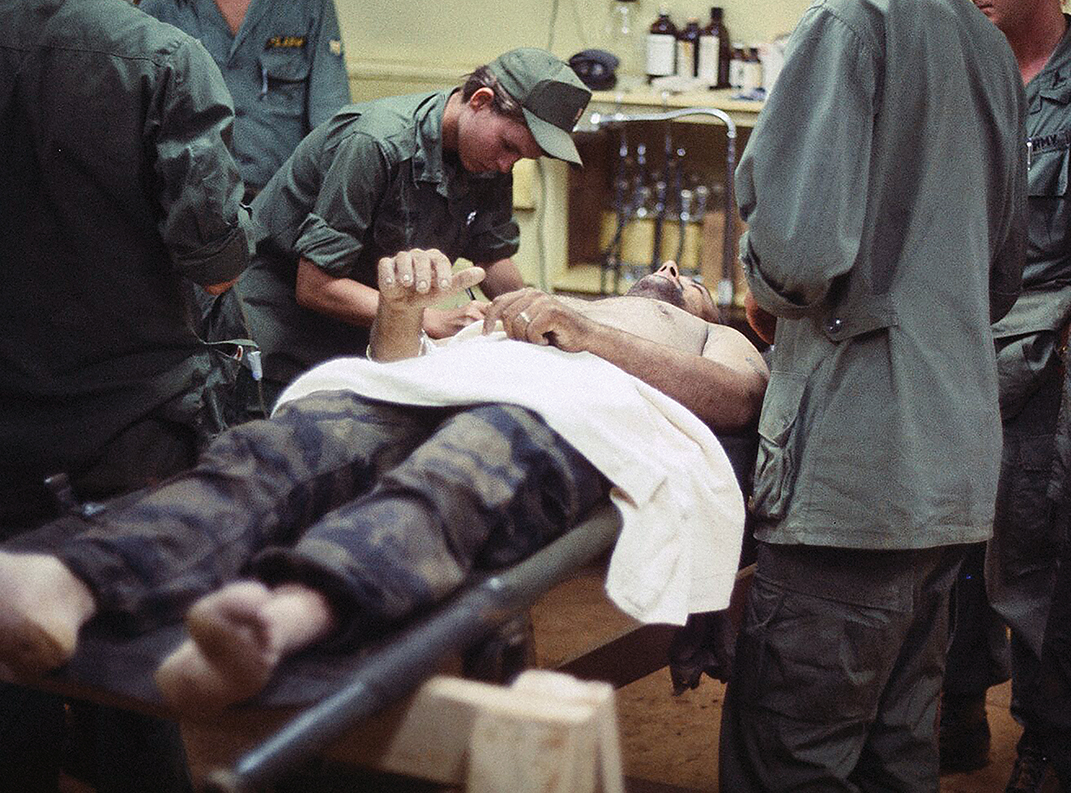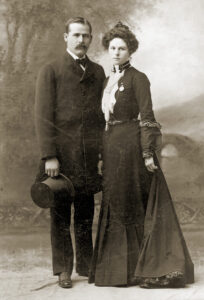“In Pleiku, the sound was faint at first, then gradually grew louder; a medevac chopper somewhere in the night sky,” writes Diane Carlson Evans, a former Army Nurse Corps captain and the founder of the Vietnam Women’s Memorial, in her book Healing Wounds. “For grunts, the sound was a benevolent god with rotor blades; for nurses, an adrenaline-pumping bird that brought us merciless, soul-harrowing work.”
For nurses in Vietnam that work occurred in Army field evacuation, surgical and MUST (Medical Unit, Self-contained Transportable) hospitals, on Navy hospital ships and aboard Air Force helicopters and planes. The average age of nurses was 23. About 65 percent had less than two years of experience, and 79 percent were women. They served in both active duty and reserve units. There was a range of tour lengths for nurses, although Army nurses, like other soldiers, served one-year tours.
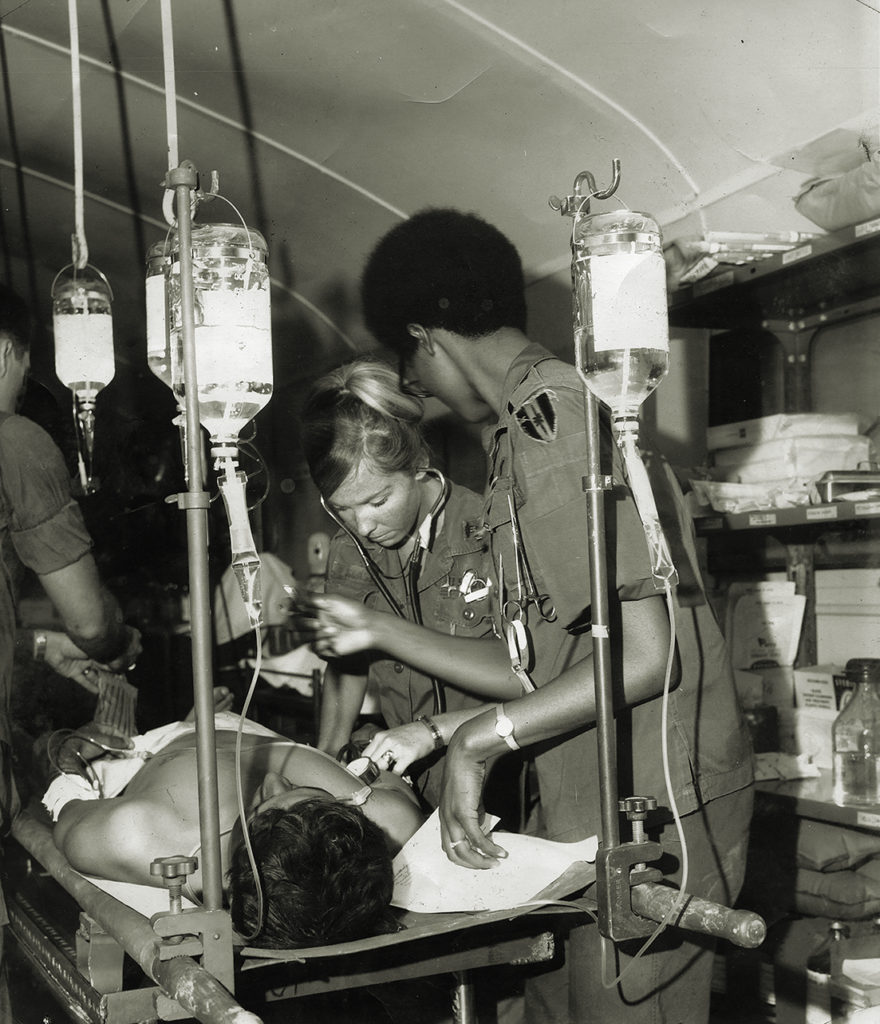
Easy Targets
Medical facilities were frequently near supply depots and airfields—targets for enemy fire, which could come from any direction at any time. Some hospitals suffered significant damage from shelling. Guards were on patrol 24/7, and barbed wire encircled the compounds. Nurses also had to deal with the loss of electricity, a lack of operating tables and shortages of supplies and equipment.
They responded with resourcefulness and creativity. Tables were constructed with discarded lumber and assorted scrap. Red Cross bags were filled with stones and used as traction weights. Combat nurses were scheduled for a 72-hour week—12 hours a day, six days a week—but after a major firefight with heavy casualties, a nurse’s shift might be 24 hours or longer. Despite all the difficulties, nurse veterans say a high level of camaraderie and the appreciation of their patients kept morale high.
Nurses in Vietnam often faced more intense demands for patient care than had been the case in previous wars. The widespread use of UH-1 Huey medevac helicopters enabled more of the severely wounded men to get to a hospital fast, sometimes within half an hour, substantially increasing the workload and pressure on nurses stationed there. Facilities for medical treatment admitted 133, 447 wounded personnel between January 1965 and December 1970, and 97,659 of them were hospitalized.
The combination of fast transport and advances in medical care resulted in a survival rate of 98 percent for those reaching a hospital in an hour or less. On average, Vietnam War patients left the hospital sooner than those in World War II and Korea because of the improved medical care. During the Vietnam War, the hospital mortality rate per thousand was 2.6 percent, compared with 4.5 percent during World War II.
First Responders
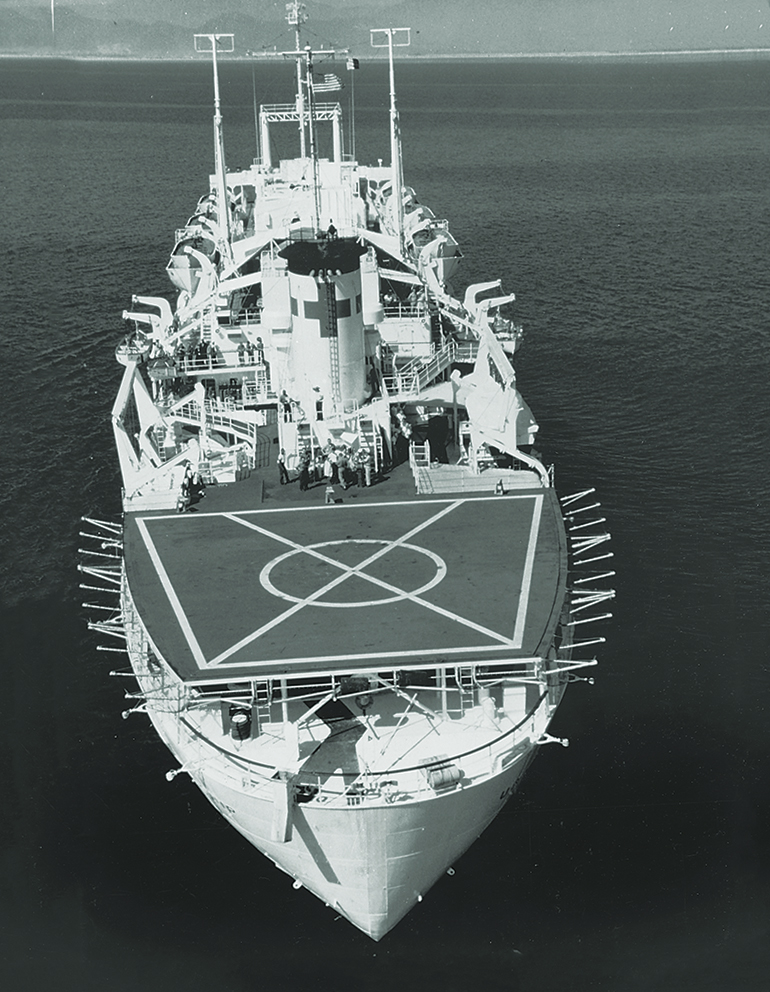
Nurses were among the earliest U.S. service members in Vietnam. The first military women to arrive were Army Nurse Corps Majs. Jane Becker, Francis Smith and her sister, Helen Smith, who landed in Saigon on April 29, 1956, on a temporary duty assignment with U.S. Military Assistance Advisory Group’s Medical Training Team. Their task was to train South Vietnamese nurses in medical procedures. In the summer of that year, Navy mobile construction battalions, the Seabees, made their first appearance in Vietnam. Hospitals were put on the Seabees’ to-do list as the American military presence expanded in the early 1960s.
Army nurses arrived in Vietnam at one of two sites: Tan Son Nhut Air Base near Saigon and Bien Hoa Air Base, about 20 miles outside the city. The Tan Son Nhut arrivals went to the 178th Replacement Company at Saigon’s Camp Alpha. The Bien Hoa arrivals reported to the 90th Replacement Battalion at nearby Long Binh. From those points, it was on to their duty assignments. A variety of buildings were converted into hospitals. Some facilities had been turned over to the Army by the South Vietnamese. Often the acquired spaces were reconfigured into an “X” shape with the nurses in the center, where they could better monitor all the patients.
Prior to 1967, tents were the primary living quarters for nurses. The tents were replaced with Seabee-constructed buildings such as simple living quarters called hooches and Quonset huts. Hooches, like those in the Central Highlands town of Pleiku, were typically made of wooden-framed buildings with window screens. Some Quonset hut residences, prefabricated structures of corrugated metal, had individual rooms. In others, the nurses shared an open bay. When hospitals moved closer to combat operations, the nurses ended up in tents again.
Navy nurses also came to Vietnam early in the war. They served on two hospital ships, USS Sanctuary and USS Repose, and at two land facilities: Station Hospital Saigon and Station Hospital Da Nang.
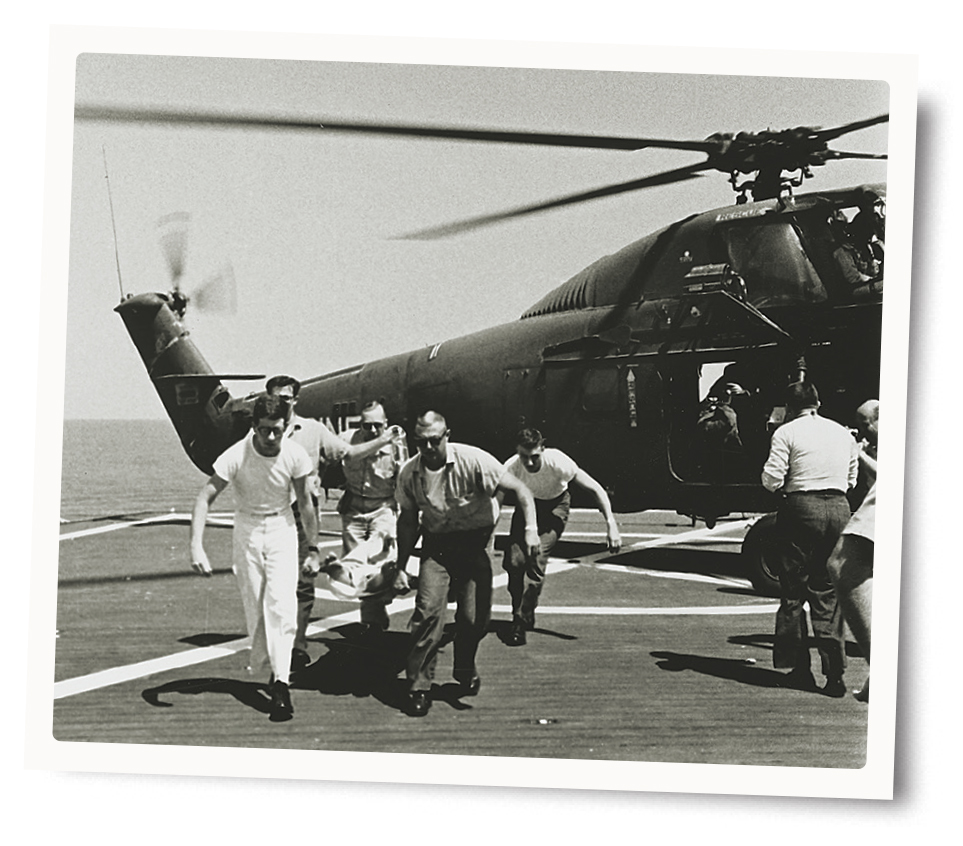
Navy Matter
In 1963 the Navy assumed responsibility for civilian and military medical activities at the U.S. Embassy in Saigon. Two members of the Navy Nurse Corps reported in February of that year. They worked at Navy Station Hospital Saigon, a five-story inpatient facility with an operating and emergency area. Four Navy nurses attached to the hospital received Purple Hearts after a Christmas Eve 1963 Viet Cong bombing of the bachelor officers’ quarters, where the nurses were staying. They were the first female members of the U.S. armed forces to earn Purple Hearts during the Vietnam War.
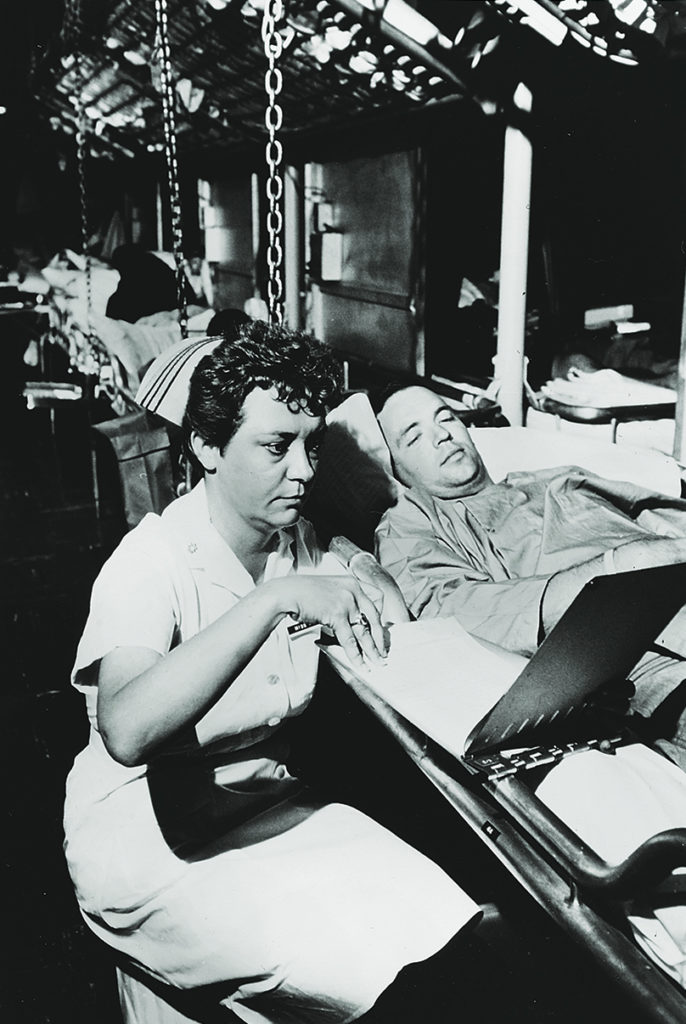
The Repose arrived in February 1966 and was stationed off the coast of the Hue/Phu Bai area in northern South Vietnam. It served there until March 1970. The Sanctuary reached Vietnam in April 1967 and was stationed at DaNang. The ship’s unofficial motto was, “You find ’em, we bind ’em.” The Sanctuary left Vietnam in April 1971.
In March 1966 the Navy’s Saigon hospital was transferred to the Army. During its Navy days, more than 6,000 patients were hospitalized. Approximately 130,000 outpatients received treatments. The Navy nurses at the Da Nang hospital served from August 1967 to May 1970, when that hospital was also turned over to the Army. It became the largest casualty treatment center in the world, with 600 beds and 63,000 patient admissions.
In 1966 the Air Force shipped to Vietnam 400-square-foot containers modified for use as hospitals. Within the next two years, a hospital at Cam Rahn Bay, about 200 miles north of Saigon, was the second largest in the Air Force, with 475 beds and 100 more for a causality staging facility. Ultimately, Cam Rahn Bay evolved into the aeromedical evacuation site for the entire theater.
In 1968 the Air Force sent the first airplane specifically designed for medevac operations to Vietnam. The aircraft, a McDonnell-Douglas C-9A, was named “Nightingale” to honor Florence Nightingale, the English nurse noted for her work during the 1853-56 Crimean War. The Air Force assigned its first female nurses to Vietnam in 1966, the majority in Cam Rahn Bay. The following year, female flight nurses became part of the medevac crews.
Army of Care
As America’s combat forces increased, so did the nursing force. In 1965 the Army had 113 hospital beds and 15 nurses in Southeast Asia. By December 1968, there were 900 nurses in Vietnam working in 23 Army hospitals and one convalescent hospital, totaling 5,283 beds. That year there were 11 Reserve and National Guard medical units in Vietnam.
During an 11-year stretch from the opening of the 8th Field Hospital in the central coastlands town of Nha Trang in March 1962 until March 29, 1973, when the last Army nurses departed after the cease-fire that ended U.S. military involvement in Vietnam, an estimated 11,000 women served there, including not only nurses but also other military women and civilians.

The rising demand for nurses in Vietnam put staffing pressures on the Army Nurse Corps, which was simultaneously providing nurses in Europe, Guam, Japan, the Philippines and the United States. A shortfall of 2,000 nurses made recruitment the highest priority for Col. Mildred Clark, chief of the Army Nurse Corps from 1963 to 1967. (Her successor, Col. Anna Mae Hays, who held the position from 1967 to 1971, was promoted to brigadier general on June 11, 1970, making her the first American woman to earn a general officer’s rank.)
Why Did Women Volunteer to Become Nurses in Vietnam?
Nurses volunteered for an array of reasons—including patriotism, a calling to help soldiers in need and a desire for adventure. Reflecting on a 30-year military career in a 2006 interview with American Nurse, Vietnam veteran Mary Jo Rice-Mahoney said: “It provided me the opportunity to travel around the world, learn about different cultures, perform various nursing procedures, make lifelong friends, and live through a combat experience. It’s where my love of nursing began.”

Rice-Mahoney joined the Army Student Nurses Program at St. Joseph’s College in Emmitsburg, Maryland, in 1968, during her third year in nursing school. She was commissioned a second lieutenant in the Army Nurse Corps six months before graduation and then reported to Fort Dix, New Jersey. She worked in an orthopedic ward and got what she described in the American Nurse interview as a crash course in “Combat Injuries 101.” In March 1969, Rice-Mahoney was ordered to report to the 67th Evacuation Hospital at Qui Nhon in the central coastal region of South Vietnam.
What Did Vietnam War Nurses Do?
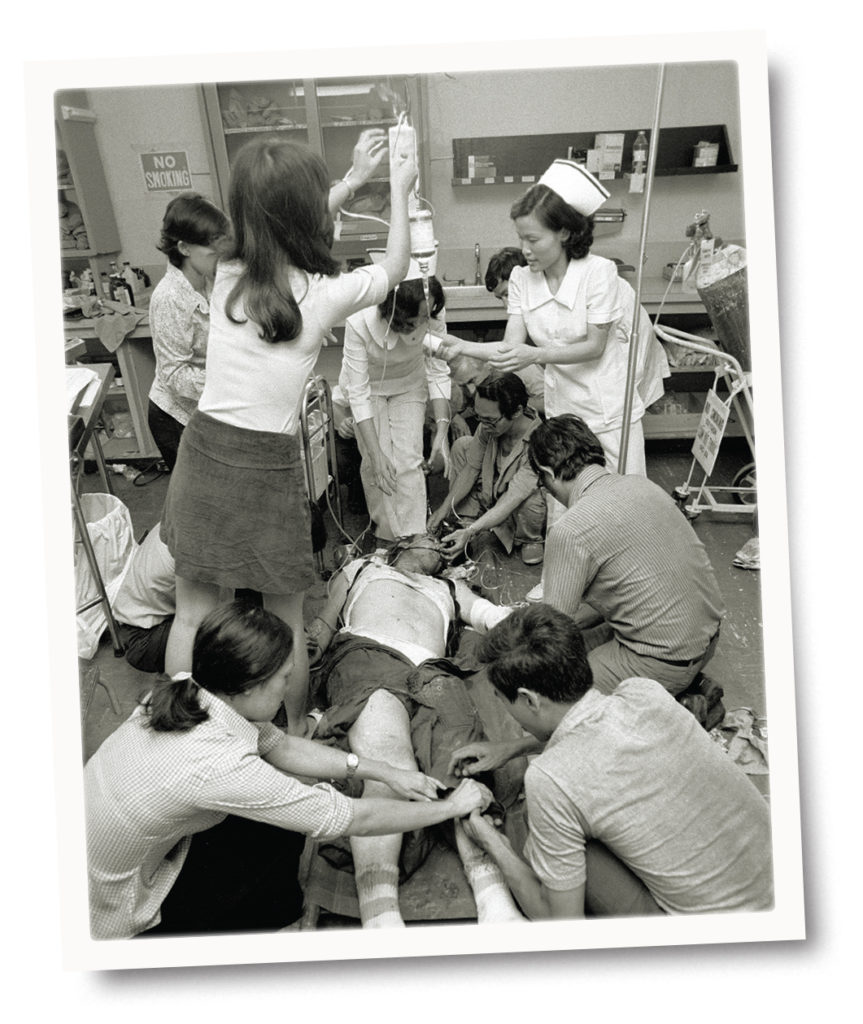
Nursing in Vietnam encompassed more than the treatment of combat wounds. As in previous wars, diseases were the most common threat to a service member’s health, accounting for nearly 70 percent of hospital admissions from 1965 to 1969. Diseases such as malaria and hepatitis were frequent. Among the worst injuries were burns. The required treatment was the application of Sulfamylon, a thick cream applied to the affected area. It was reapplied every four to six hours after the previous cream had been removed, a very painful process. A heavy dose of narcotics did not keep many from crying out in pain.
Military nurses also treated allied forces, American civilians and Vietnamese men, women and children. In their free time, many visited local villages and their hospitals to participate in U.S.-funded health programs through the Medical Civic Action Program, or MEDCAP.
Time for relaxation was rare. The beaches at Cam Rahn Bay and China Beach in Da Nang were popular gathering spots. Nurses got together for music and dancing, broke the rules by riding in helicopters and airplanes to view the landscape and the South China Sea, attended USO performances featuring popular entertainers and had a one-week furlough for rest and recuperation out of the country. Australia, Japan, Hong Kong and Thailand were locations available for R&R.
LEAving Vietnam
The last Army nurses left Vietnam on March 29, 1973, two months after the cease-fire. However, more service and sacrifice were still to come. On April 4, 1975, as Saigon was about to fall to communist forces, the Air Force conducted Operation Babylift to fly orphans from Vietnam to the Philippines, a stop on their way to the United States for adoption. Air Force Nurse Corps Capt. Mary Klinker and about 130 passengers died when a Babylift C-5 cargo plane experienced a malfunction shortly after taking off from Tan Son Nhut airport and crashed. Klinker was 27.
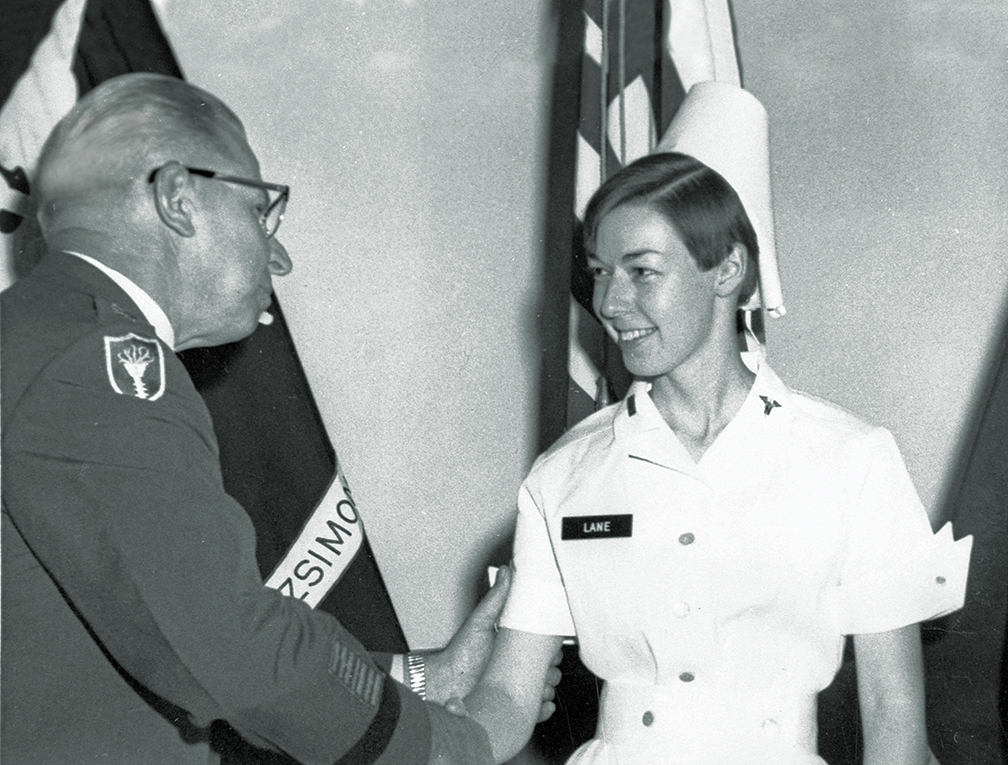
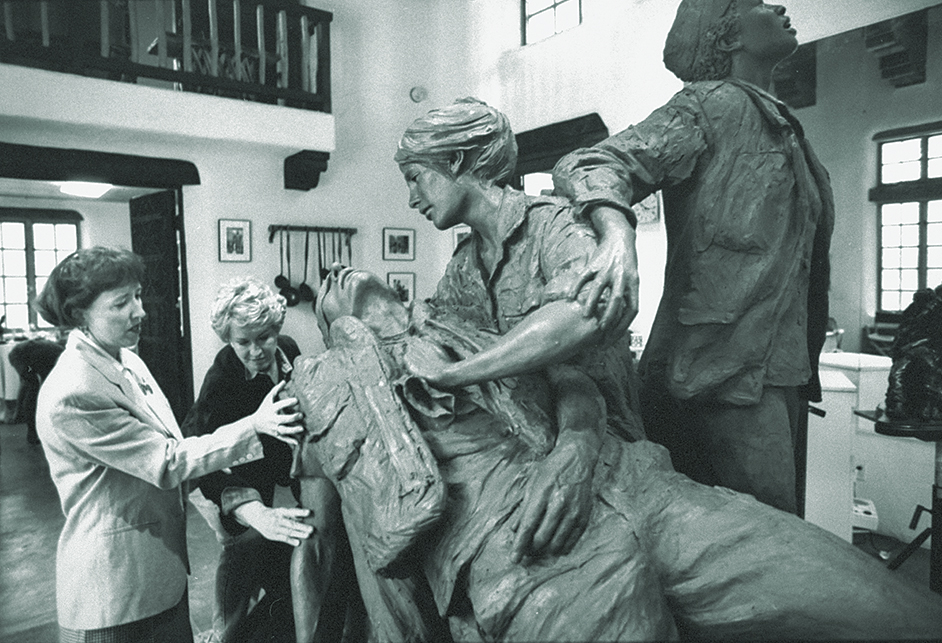
The names of eight women are engraved on the wall of the Vietnam Veterans Memorial. All were nurses—four died in plane or helicopter crashes, one from illness, one from a stroke and one from enemy fire. On June 8, 1969, 25-year-old 1st Lt. Sharon Lane of Canton, Ohio, was killed in a Viet Cong rocket attack on the 312th Evacuation Hospital in Chu Lai in northern South Vietnam.
Evans, author of Healing Wounds, came up with the idea for the Vietnam Women’s Memorial in 1983 and founded the Vietnam Women’s Memorial Project in 1984. Ten years later her dream was realized. A groundbreaking was held on July 29, 1993, and the memorial was dedicated on Nov. 11, 1993. The centerpiece of the memorial is sculptor Glenna Goodacre’s bronze statue showing three military women with a wounded soldier.
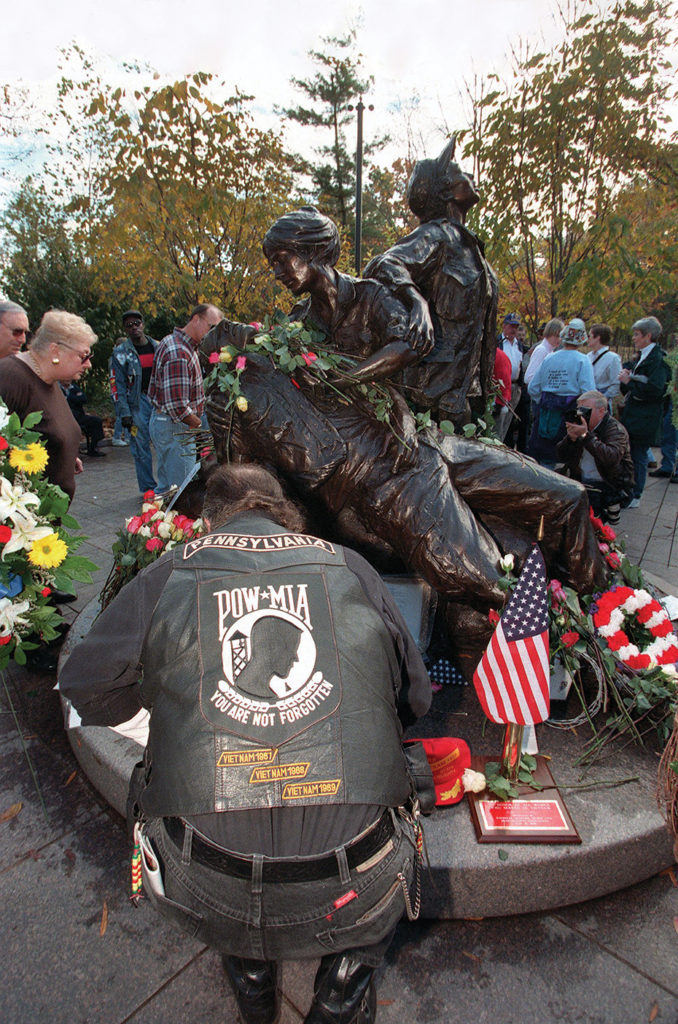
The 6-foot, 8-inch sculpture honors not only nurses but all 265,000 women, military and civilian, who served throughout the world during the Vietnam era. It is positioned about 100 yards from the apex of the V-shaped wall of the Vietnam Veterans Memorial. Evans served as president and CEO of the Vietnam Women’s Memorial Foundation (her organization’s name since 2002) for more than 30 years.
Nurses who came home carried with them experiences and emotions that changed their lives. “I learned so many lessons, but it took me years to put them into words or concrete thoughts,” Janis Nark, a Detroit native who served as an Army nurse in Vietnam 1970-71, said in a 2015 article, “Angels of War,” published on the website of the Vietnam Veterans Memorial. “Vietnam hardened me,” she added, but also said, “It heightened my sense of humor. It made me realize what’s important in life, and what isn’t.”
Tom Edwards, a Navy veteran who served in Vietnam 1968-69, is a freelance writer/photographer in Forest Lake, Minnesota. He thanks Diane Carlson Evans for her assistance with this article.
Nurses on the Wall
Eight women died in the combat zone. All were nurses.
2nd Lt. Carol Ann Elizabeth Drazba, 22, Pennsylvania, Army, 3rd Field Hospital, Saigon. Killed Feb.18, 1966, in a helicopter crash.
2nd Lt. Elizabeth Ann Jones, 22, South Carolina, Army, 3rd Field Hospital, Saigon. Killed Feb. 18, 1966, with Drazba in a helicopter crash.
Capt. Eleanor Grace Alexander, 27, New Jersey, Army, 85th Evacuation Hospital in Qui Nhon in the central coastal region. Killed Nov. 30, 1967, in a plane crash.
1st Lt. Hedwig Diane Orlowski, 23, Michigan, Army, 67th Field Evacuation Hospital in Qui Nhon. Killed Nov. 30, 1967, with Alexander in a plane crash.
2nd Lt. Pamela Dorothy Donovan, 26, Massachusetts, Army, 85th Evacuation Hospital in Qui Nhon. Died July 8, 1968, attributed to pneumonia.
Lt. Col. Annie Ruth Graham, 51, North Carolina, Army, 91st Evacuation Hospital in Tuy Hoa in the central coastlands. Died from a stroke on Aug. 14, 1968.
1st Lt. Sharon Ann Lane, 25, Ohio, Army, 312th Evacuation Hospital in Chu Lai
on South Vietnam’s northern coast. Died June 8, 1969, when a rocket struck the hospital where she worked.
Capt. Mary Therese Klinker, 27, Indiana, Air Force, medical team onboard a C- 5 Operation Babylift plane transporting Saigon orphans destined for the U.S. Killed April 4, 1975, when the plane crashed after experiencing pressure problems after takeoff.
This article appeared in the Autumn 2022 issue of Vietnam magazine.
GET HISTORY’S GREATEST TALES—RIGHT IN YOUR INBOX
Subscribe to our HistoryNet Now! newsletter for the best of the past, delivered every Monday and Thursday.

